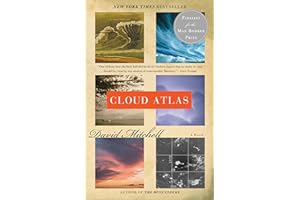One sentence summary
Cloud Atlas is a critically acclaimed novel by David Mitchell that follows the stories of six main characters which are interwoven across hundreds of years, from the mid-19th century to a post-apocalyptic future.
Book genre
Cloud Atlas is categorized as a post-modernist historical fiction novel.
Main topic of the book
The main topic of Cloud Atlas is the power of human connection to deal with a fractured world.
Key ideas
- The novel follows protagonists in six stories spanning different timelines and genres, showing how our lives and decisions intertwine across time and space.
- It explores the idea of reincarnation or destiny across generations.
- Humans are capable of transcending the twists and turns of fate if they make conscious decisions to act out of altruism and love.
Main parts of the book and a short summary
- The Pacific Journal of Adam Ewing (1850s): The first story follows a lawyer who embarks on a journey across the Pacific Ocean for business purposes. Along the way, he meets a doctor who heals his tungusic ailment, and a treacherous priest. This section examines themes of slavery and colonization.
- Letters from Zedelghem (1930s): We join Robert Frobisher, a talented young composer, who is sent to work as an amanuensis for a famous composer in Belgium. As he falls in love, he pens a series of letters discussing love and identity.
- Half Lives, The First Luisa Rey Mystery (1970s): We follow a journalist, Luisa Rey, as she investigates a nuclear reactor with the help of a mysterious stranger. This story focuses on corporate greed and corruption.
- The Ghastly Ordeal of Timothy Cavendish (2000s): This story follows the publisher of a vanity press book who is misplaced in a nursing home. The story takes on an absurd entertainment quality with a comical bureaucratic villain.
- An Orison of Sonmi~451 (Future): The fifth story follows a fabricant (genetically engineered human) in a dystopian world who transcends her origins. This story is an exploration of freedom, cultural oppression and individual power.
- Sloosha’s Crossin’ an’ Ev’rythin’ After (Post-Apocalyptic): The final story follows Zachry, whose Pacific island survived a cataclysm. This story ties together all of the preceding stories, reflecting on how far humanity has come and how far it still has to go.
Key takeaways
- People are connected in ways beyond our understanding.
- We all have an ultimate destiny we are trying to reach and our lives are interlinked along the way to help us get there.
- There is power in making conscious decisions in order to make positive change to the world.
Author’s background and qualifications
David Mitchell is a British novelist and screenwriter from Southport, England. He is the author of several well-received novels, including Ghostwritten, Number9Dream and Black Swan Green, as well as Cloud Atlas. He has been shortlisted for the Booker Prize twice and his books have been adapted into stage plays, radio plays, and television series.
Target audience
Cloud Atlas is suitable for readers aged 18+ who enjoy post-modernist fiction. It is also suitable for readers who are looking for an exploration of human connection and destiny.
Publisher and first publication date
Cloud Atlas was first published by Sceptre in 2004.

